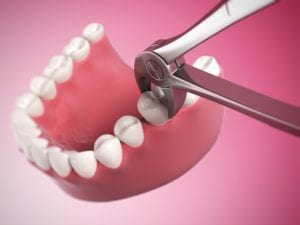While your dentist’s main goal is preserve all the teeth in your mouth, there are certain cases where this may not be possible. In these cases, an extraction is usually recommended to remove the problematic tooth and prevent your oral health from declining. Dental extractions can either be simple or surgical. Simple extractions use a special tool to elevate the tooth from the socket, as well as forceps to gently remove the tooth. Since the simple extraction method is used to remove the entire tooth in one piece, it can only be used to extract teeth that have completely erupted from the gums and are able to be safely extracted in one piece.
For teeth that are partially or completely impacted below the gums, as well as teeth that cannot be extracted in one piece, a surgical extraction method may be used. Surgical extractions break the tooth into smaller pieces and will require a tiny gum incision in the case of impacted teeth. Then, each piece is removed one by one in order to minimize the trauma to the surrounding soft tissues and promote faster healing.
Did You Know?
Tooth extractions are considered to be a surgical dental procedure. However, they do not require hospitalization and most cases can be completed in your dentist’s office. For more severe cases, a referral to an oral surgeon may be needed.
Frequently Asked Questions:
Am I a candidate for an extraction?
You may be a candidate for a tooth extraction if you have a tooth that is severely decayed or damaged beyond the point of restorative procedures. You may also be a candidate for an extraction if you have too many teeth for the size of your mouth or if you have partially or fully impacted wisdom teeth that are causing problems. In order to determine if a tooth extraction is needed, your Hemet dentist will perform an exam and dental x-rays.
What should I expect when having a tooth extracted?

Because expectations for tooth extractions can vary, you will have a pre-operative appointment to discuss your case, the treatment plan, and dental sedation options. During this appointment, your dentist will explain what you should expect and answer any questions you may have.
The day of your extraction, you are asked to arrive in loose-fitting clothes and closed-toed shoes. You should also be fasting for the amount of time specified at your pre-op appointment. Depending on the level of sedation used, you may be conscious and relaxed, lightly sleeping, or completely unconscious. Dental anesthetics will also be used, so you will only feel pressure and no pain during the extraction.
What should I expect after having a tooth extracted?
After having a tooth extracted, you can expect to have cotton rolls or gauze stuffed around the extraction site to control any residual bleeding. Immediately after the procedure, you will likely not feel any pain because your mouth will still be numb. However as the anesthetic wears off, you may experience some pain or soreness at the extraction sites. In most cases, this can be managed with over the counter pain medications.

In the days following your extraction, you can also expect to have some swelling in the area surrounding the extraction site. Generally, you can expect your swelling to peak three days after the extraction, then it will begin to subside. To manage the swelling, as well as any discomfort, you can use ice in the first 48 hours and heat after that for 20 minutes on and 20 minutes off.
You can also expect that your dentist will provide you with post-operative instructions to follow during your recovery period. These instructions will have directions on how to keep the extraction site clean, as well as what foods to eat after a tooth extraction. Additionally, they will also contain more detailed information on what to expect after a tooth extraction. By following these instructions diligently, you can expect to likely recover from your extraction in about 7-10 days.


Recent Comments